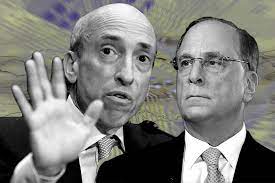There is a rampant confusion regarding the guidelines imposed by the SEC to all BTC ETF applicants. The following article clarifies a few points of confusion regarding the matter.
While BTC Futures ETF were launched in the recent past by ProShares and Vaneck, a spot BTC ETF is still unavailable in the American financial markets. The finance behemoth, BlackRock, the largest money-management firm in the world with more than US$10 trillion and which only faced one rejection in all its ETF application, has been pushing a BTC spot ETF while incessantly promoting it in the media (especially through its leader and CEO Larry Fink). The insistence of BlackRock has fueled the recent optimism and euphoria in all discussions regarding crypto but let’s clarify and make sure a few point are well understood:
- What is spot ETF in simple terms? – Spot Bitcoin ETF is an investment vehicle strategically designed to mirror the price movements of Bitcoin. Each share denotes the entitlement to redeem a percentage of physically held BTC within the fund.
2. Mechanisms of ETF Share Tracking: ETF shares respond to market dynamics through two key mechanisms:
a) Investors engage in buying/selling shares on the open market.
b) Approved institutional investors participate in “creating” new shares or “redeeming” shares for the underlying assets.
3. Role of ETF Issuers: ETF issuers, such as BlackRock and ARK, manage the fund and oversee the share creation/redemption process. They are also responsible for managing the Bitcoin reserve underlying the ETF.
4. Revenue Generation for Issuers: Issuers automatically generate revenue by deducting fees through the daily sale of a percentage of BTC holdings.
5. Authorized Participants (APs) Defined: APs, large financial institutions like Goldman Sachs and Citadel, enter agreements with ETF issuers exclusively for the creation/redeeming of ETF shares. Only APs possess the authority to create/redeem ETF shares.
6. AP Profit Mechanism: APs profit from the price differential between the underlying asset and the ETF share price. For instance, if Bitcoin ETF shares trade above the actual Bitcoin price, APs could capitalize by creating new shares and selling them at a profit.
7. In-Kind ETF Creation Method: ETFs can adopt either an “In-Kind” or “Cash Creates” creation model. In an In-Kind model, APs handle the buying/selling of physical Bitcoin. When creating shares, APs send BTC they already own to the ETF issuer, and upon redemption, the issuer sends them actual BTC.
8. Cash Creates Defined: In a Cash Create model, the ETF issuer, such as BlackRock, manages the purchase/sale of BTC. When APs create shares, they send cash to the issuer, who then buys the BTC. During redemption, the issuer sells BTC and sends cash to the AP.
9. Issuers’ Preference for In-Kind: Issuers favor the In-Kind model due to tax advantages, lower fees, and reduced pressure on the BTC price, allowing APs to redeem shares without necessarily selling the received BTC.
10. SEC Mandate for Cash Creates: The SEC mandates Cash Creates to prevent money laundering and price manipulation by limiting the involvement of unregistered third parties handling BTC. APs are typically restricted from trading physical crypto.
11. Physical Bitcoin Transactions with Cash Creates: Yes, physical Bitcoin is still bought/sold using the Cash Creates method. The distinction lies in who conducts the buying/selling.
12. Effects of ETFs Using Cash Creates: Potential impacts include reduced investment interest due to increased fees/taxes and potentially more pronounced effects on the Bitcoin price when APs create/redeem shares.
13. Investment Approach of BlackRock/Other Fund Issuers: Fund issuers like BlackRock don’t directly invest in Bitcoin personally. They acquire Bitcoin on behalf of third-party investors, earning fees irrespective of market price fluctuations.
14. Court’s Ruling on SEC Approval: The recent Grayscale court ruling did not conclusively determine that the SEC must approve an ETF. Rather, it emphasized the SEC’s need for a more comprehensive explanation regarding the distinct risk profiles of Spot ETFs compared to already approved Bitcoin Futures ETFs. The SEC retains the legal authority to deny or delay applications.
15. Positioning of These Spot BTC ETFs: While these are the initial Spot BTC ETFs in the United States, several other countries have already established spot ETFs.
16. Institutional Investors and Bitcoin: Institutional investors, such as wealth managers and pension funds, have already invested in Bitcoin directly through custodians or indirectly through assets like futures ETFs, $GBTC, $MSTR, mining stocks, and exchange stocks. A considerable percentage of interest in a Bitcoin Spot ETF is likely to originate from existing investment vehicles.

Gensler (SEC) vs Fink (BlackRock)

